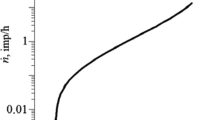An acoustic-emission model of local fracture (crack propagation) of the material is constructed. Based on this, a method of determining the residual life of thin-walled structural elements under the action of long-term static load and corrosive environment has been developed. The size of the crack and the stress in its plane are determined by the parameters of the acoustogram written from the structural element during crack propagation. To demonstrate the application of this method, a numerical experiment is conducted and the residual life of the plate is determined.

Similar content being viewed by others
References
V. V. Panasyuk, and I. M. Dmytrakh, Influence of Corrosive Environments on the Local Fracture of Metals near Stress Concentrator [in Ukrainian], Karpenko Phys. Mech. Inst. NASU, Lviv (1999).
O. N. Romaniv, and H. M. Nykyfrocrhyn, Mechanics of Corrosion Fracture of Structural Alloys at Stress Concentrators[in Russian], Metallurgiya, Moscow (1986).
P. Arnoux, “Atomistic simulations of stress corrosion cracking,” Corr. Sci., 52, Is. 4, 1247–1257 (2010); https://doi.org/10.1016/j.corsci.2009.12.024.
K. Sieradzki, and R. S. Newman, “Stress-corrosion cracking,” J. Phys. Chem. Solids, 48, Is. 11, 101–113 (1987); https://doi.org/10.1016/0022-3697(87)90120-X.
Z. T. Nazarchuk, V. R. Skalskyi, and T. V. Selivonchak, Acoustic-Emission Diagnosis of Corrosion-Hydrogen Cracking of Structural Steels [in Ukrainian], Naukova Dumka, Kyiv (2019).
Z. Nazarchuk, V. Skalskyi, and O. Serhiyenko, Acoustic Emission. Methodology and Application, Cham: Springer Int. Publ. AG (2017).
V. R. Skalskyi, O. E. Andreikiv, and O. M. Serhienko, “Investigation of the plastic deformation of materials by the acoustic emission method (review),” Mater. Sci., 39, No. 1, 86–107 (2003); https://doi.org/10.1023/A:1026182630649.
P. Ziehl, and M. El Batanouny, “10-Acoustic emission monitoring for corrosion damage detection and classification,” in: Corrosion of Steel in Concrete Struct., (2016), pp. 193–209.
W. W. Gerberich, R. H. Jones, M. A. Friesel, and A. Nozue, “Acoustic Emission Monitoring of Stress Corrosion Cracking,” Mat. Sci. and Eng., A103, Is. 1, 185–191 (1988); https://doi.org/10.1016/0025-5416(88)90565-4.
C. Jomdechaa, A. Prateepasena, and P. Kaewtrakulpongb, “Study on source location using an acoustic emission system for various corrosion types,” NDT &E Int., 40, Is. 8, 584–593 (2007); https://doi.org/10.1016/j.ndteint.2007.05.003.
M. G. Alvarez, P. Lapitz, and J. Ruzzante, “Analysis of acoustic emission signals generated from SCC propagation,” Corr. Sci., 55, 5–9 (2012); https://doi.org/10.1016/j.corsci.2011.08.014.
Z. T. Nazarchuk, and V. R. Skalskyi, Acoustic Emission Diagnostics of Structural Elements” in: Means and Application of the Acoustic Emission Method (Vol. 3) [in Ukrainian], Naukova Dumka, Kyiv (2009).
V. R. Skalskyi, and P. M. Koval, Acoustic Emission during Fracture of Materials, Products and Structures. Methodological Aspects of Information Extraction and Processing [in Ukrainian], Spolom, Lviv (2005).
Yu. I. Bolotin, L. A. Maslov, and V.I. Polunin, “Establishing correlations between the crack size and the amplitude of acoustic emission pulses,” Defektoskopiya, Is. 4, 119–122 (1975).
W. W. Gerberich, D.G. Atteridge, and J.F. Lessar, “An acoustic emission investigation of microscopic ductile fracture,” Metallurgical Transact. A, 6, Is. 4, 797–801 (1975); https://doi.org/10.1007/BF02672302.
I. C. Radon, and A. A. Pollock, “Acoustic emission and energy transfer during crack propagation,” Eng. Fract. Mech., 4, Is. 2, 295–310 (1972); https://doi.org/10.1016/0013-7944(72)90043-4.
J. Yu, P. Ziehl, B. Zarate, and J. Caicedo, “Prediction of fatigue crack growth in steel bridge components using acoustic emission,” J. of Constructional Steel Research, 67, Is. 8, 1254–1260 (2011); https://doi.org/10.1016/j.jcsr.2011.03.005.
M. V. Lysak, “Development of the theory of acoustic emission by propagating cracks in terms of fracture mechanics,” Eng. Fract. Mech., 55, Is. 3, 443–452 (1996); https://doi.org/10.1016/0013-7944(96)00026-4.
O. E. Andreikiv, V. R. Skal’s’kyi, I. Ya. Dolins’ka, and Yu. Ya. Matviiv, “Determination of the period of subcritical growth of creep cracks according to the parameters of acoustic emission,” Mater. Sci., 50, No. 2, 201–211 (2014); https://doi.org/10.1007/s11003-014-9709-4.
O. Ye. Andreikiv, V. R. Skalskyi, and I. Y. Dolinska, “Theoretical foundations of the method of acoustic emission for the diagnostics of delayed fracture of materials,” Mater. Sci., 57, No. 3, 355–365 (2021); https://doi.org/10.1007/s11003-021-00550-1.
Z. Zhang, Z. Zhang, J. Tan, X. Wu, “Quantitatively related acoustic emission signal with stress corrosion crack growth rate of sensitized 304 stainless steel in high-temperature water,” Corr. Sci., 157, 79–86 (2019); https://doi.org/10.1016/j.corsci.2019.05.030.
H. Shaikh, R. Amirthalingam, T. Anita, N. Sivaibharasi, T. Jaykumar, P. Manohar, and H. S. Khatak, “Evaluation of stress corrosion cracking phenomenon in an AISI type 316LN stainless steel using acoustic emission technique,” Corr. Sci., 49, Is. 2, 740–765 (2007); https://doi.org/10.1016/j.corsci.2006.06.007.
O. E. Andreikiv, and N. B. Sas, “Subcritical growth of a plane crack in a three-dimensional body under the conditions of high-temperature creep,” Mater. Sci., 44, No. 2, 163–174 (2008); https://doi.org/10.1007/s11003-008-9064-4.
O. E. Andreikiv, and N. I. Tym’yak, “Electrochemical model of local corrosion at the tip of a loaded crack,” Mater. Sci., 30, No. 1, 19–24 (1995); https://doi.org/10.1007/BF00559011.
M. P. Savruk, Stress Intensity Factors in Bodies with Crack, Naukova Dumka, Kyiv (1988).
O. N. Romaniv, S. Ya. Yarema, H. N. Nykyforchyn, N. A. Makhutov, and M. M Stadnyk, “Fatigue and cyclic crack-growth resistance of structural materials,” Vol. 4, in: V. V. Panasyuk (Ed.), Fatigue and Cyclic Crack Growth Resistance of Structural Materials [in Russian], Naukova Dumka, Kyiv (1990).
Author information
Authors and Affiliations
Corresponding author
Additional information
Translated from Fizyko-Khimichna Mekhanika Materialiv, Vol. 58, No. 6, pp. 5–11, November–December, 2022.
Rights and permissions
Springer Nature or its licensor (e.g. a society or other partner) holds exclusive rights to this article under a publishing agreement with the author(s) or other rightsholder(s); author self-archiving of the accepted manuscript version of this article is solely governed by the terms of such publishing agreement and applicable law.
About this article
Cite this article
Andreikiv, O.Y., Dolinska, I.Y. & Zviahin, N.S. Acoustic-Emission Method of Determining Residual Life of Thin-Walled Structural Elements Under the Action of Force Loads and Corrosive Environments. Mater Sci 58, 693–700 (2023). https://doi.org/10.1007/s11003-023-00718-x
Received:
Published:
Issue Date:
DOI: https://doi.org/10.1007/s11003-023-00718-x




